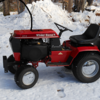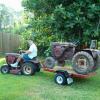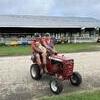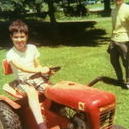Leaderboard
-
in all areas
- All areas
- Markers
- Marker Comments
- Marker Reviews
- Articles
- Article Comments
- Article Reviews
- Classfieds
- Classified Comments
- Classified Reviews
- Wiki's
- Wiki Comments
- Wiki Reviews
- Blog Entries
- Blog Comments
- Images
- Image Comments
- Image Reviews
- Albums
- Album Comments
- Album Reviews
- Files
- File Comments
- File Reviews
- Posts
-
Today
-
All time
November 28 2011 - December 10 2025
-
Year
December 10 2024 - December 10 2025
-
Month
November 10 2025 - December 10 2025
-
Week
December 3 2025 - December 10 2025
-
Today
December 10 2025
- Custom Date
-
All time
Popular Content
Showing content with the highest reputation on 12/10/2025 in all areas
-
8 points
-
6 pointsGot the transaxle case back together on my C-120, after changing out the differential assy. Of course, that's when I realized that the only oil I have on hand is all 30W Anybody need a good diff with trashed axles? Or, does anyone have any good "repurposing" ideas? I suppose I could get a forge and make a few swords.
-
5 pointsI always seem to have my eyes open for good tires/rims for my tractors. It can be a bit of a pain measuring accurately. Most rims have a deeper offset that Wheel Horse has (at least on the models I have). I carry this little board in my truck for whenever the need arises. Measured from the correct spot or not at lease I knew if they'd fit.
-
5 points
-
4 pointsNobel Prize Day is celebrated each year on December first. Celebrating excellence in diverse fields, the Nobel Prize recognizes individuals for their outstanding contributions to humanity's progress. One of the highest honors that can be earned in various forms of science and other admirable work, the Nobel Prize is awarded annually on Nobel Prize Day. The first Nobel Prizes were awarded on December 10, 1901, which was the fifth anniversary of the death of Alfred Nobel. Nobel was a Swedish scientist, inventor and businessman who was also passionate about writing drama and poetry. He is particularly notable as the inventor of dynamite and other high explosives, and held more than 350 patents in his lifetime. When Alfred Nobel wrote his will in 1895, it established that prizes would be awarded each year to commemorate and honor those who made significant achievements in the areas of science, medicine, literature and peace. Most of his fortune was left to this cause and, although no official reason was given for the motivation behind the prizes, many have guessed it was his guilt over being the person who invented such destructive weapons that made him want to start the endeavor. Now, for more than a century, Nobel Prizes have been awarded each year on Nobel Prize Day in Stockholm, Sweden, where Alfred Nobel was born and where he spent a large portion of his adult life.
-
4 pointsI looked a little bit for the work your horse thread but failed ... my penance is reading all upmteen pages of this one ... As long as we're wrenching on sno machines. This one in the shop for oil & filter. Is it just me or does a motor just seem to run better with fresh oil? Should have cleaned the carb ... surging abit and seafoam aint workin. Need it tho so after today's cleanup. Grass screen was rusty ... I think they look cool in red ... Do I have a problem?
-
4 points
-
4 pointsWeights are copies of the weights shipped here, a friend of ours Shaun made moulds for all the weights and then had a ton of them cast from the old brake discs and drums he's stockpiled for years. They do look really good!
-
4 pointsI looked at mine, and swore at it for a bit because the side panel wont go back on. Then went back inside.
-
4 points
-
4 pointsEvery one makes mistakes. Good people own up to them and do all that they can to correct the mistake. Great people try to help correct a mistake that was not even their fault.
-
4 pointsAdded a lift assist spring for snowblower on the 702. Made it definitely easier to raise up. With my lower back issues I need any help I can.
-
3 points
-
3 pointsWe have more snow this year then then last couple of years put together and winter just started. Another 5 inches last nite. Girls are gonna get another workout today.
-
3 pointsLook what I found in mail today. New decal for HY2 lift lever on 1257. Cant wait to see what it looks like on tractor. How lucky are we to have a member like @Vinylguy as a member here?????
-
3 points
-
3 pointsHad a few inches last week. Schools canceled because of the timing. Grand kids showed up and rode sleds for hours! Plus a snowman and ate like linebackers. I like it! The view from the WH shed down the double diamond.
-
3 pointsAside from my time in the Army, I've lived my whole life in NC. When I was younger, you learned how to drive in the snow and just did it. It didn't matter if your vehicle was rear wheel drive only. You just used your hat holder the way it was intended. Maybe after a day or two a plow truck (or your local farmers) would clear the roads. But we did well regardless. Years later, the brine trucks started running. Melted all the snow, which re-froze at night and created a two lane ice sheet. Wrecks everywhere. Someone will have to help me understand why such things are better...
-
3 pointsIs that called an F plate because one might look under the tractor and say “The F in plate is cracked?”
-
3 pointsOur roads are still covered with a dusting(of brine, not snow) from last weeks forecast of a possible dusting of snow. Can't wait till spring when the 12 million gallon of Pa brine gets washed down the river to the Chesapeake Bay. The increased salinity should bring the rock fish and crabs up to my end of the Bay. Maybe I can sell enough crabs to replace a couple rusted up vehicles.
-
2 pointsFor the little town of Knox local we have already exceeded half the normal snowfall for the season. Several springs ago I picked up this tall chute from a member in PA. The only use it's had was just when I wanted to play with it. That is until this year. A recent snowfall of 10+" of very heavy wet stuff won the battle with the Reborn B-80 blade tractor. I fired up the 05 with the blower and it did the trick. But I was on and off the seat multiple times to adjust the chute deflector. I just eliminated that problem this morning. I didn't want anything 'permanent' on the tractor. The 6" stroke proved to be perfect mounted like this. I did a little video but I can't get it to transfer to YouTube.
-
2 pointsHydraulic hose grommet ready to be installed. Hydraulic hose grommet installed. Hydraulic supply line temporary plug removed, ready for valve installation. Hydraulic valve assembly ready to be installed. Hydraulic valve assembly installed. Hydraulic hoses ready to connect to cylinder. Hydraulic hoses connected to cylinder. Hydraulic return line ready to be installed. Hydraulic return line installed. Hydraulic lines and fittings tightened at valve. Hydraulic lines and fittings tightened at filter adapter. Hydraulic supply line tightened at pump. Overview as of today.
-
2 points5-6" here. Wet snow. 4:45 am cleared three drives before work... used the Dewalt blower so's not to wake up the old ladies... quiet as a mouse and, since it's not red, done under the cover of darkness with no pictures... Besides - I had to get it done so I could get inside and wish @ebinmaine a happy birthday...
-
2 pointsMy young days were spent atop the Appalachians in western Pa. My daily driver was my '30 Dodge Brothers "6". With chains on the rear 5.5X18 tires, it would handle 10" unplowed snows with no problem. The March 1958 storm did close rt. 160 where we lived for two weeks. We could hear the snow blower operating for two days before it reached our house. They cleared one lane and ever mile would back up and make a passing lane. It created some long interesting rides on the 17 mile trip to high school as it was understood most vehicles including the coal trucks were expected to back up to the passing lane when they met a school bus. Farmers eventually used their FELs to create more passing lanes. I lived near that small black 110-140" dot at Somerset.
-
2 points
-
2 points
-
2 points
-
2 points
-
2 pointsWhen they start to swear back then it's definitely time to go back inside.
-
2 pointsYes sir! I think before I moved here the city (Raleigh) completely dropped the ball on an actual 100 year snow event. Since then it seems they have shot way past what is necessary. Ground temp is well above freezing, it has been pretty wet for a NC winter and they still brine and salt. I went outside to start my car. Cold for here, back deck was an ice sheet. yard dusted. Driveway was clear, roads clear, overpasses clear. ALL roads looked like there was a snow event. No sir! Just excessive salt and brine. As previously stated... great for me, on the road virtually alone. Super stress free. All (snow) gone by 10 am.
-
2 points
-
2 points
-
2 pointsYeah, There's that too. I was thinking of the words that come out as your shoveling. Don't eat the yellow snow...
-
2 points
-
2 points
-
2 points
-
2 pointsChanged out the TU pulley on Frankie. I has a few of these plastic ones. JD uses them and my son has a 324 that has them on the hydro pulley. I know he has to be pushing 500 hours with no issues. I put one on the hydro and I must say they are smooth. Very smooth. Now I know why they are used by JD.
-
1 pointI used mine yesterday as a place to put the shed pad lock while I got a couple ears of corn for the squirrel feeder.
-
1 point
-
1 point
-
1 pointIf the engine has a voltage regulator in the front of the engine flywheel cover it is a 15 amp.
-
1 point
-
1 pointWell it lives! I left Ewan with an axle bolted on, he’s done the clutch and got it running. next step will be a test drive. Might be a run out with C4 and some extreme testing 6C4FCCBD-20EA-45AD-BE02-F5A70638B51A.mov
-
1 pointThis is one example of where Wheel Horse employees downgraded their quality in my opinion. The old steel wheel snowblower setup was a better idea.
-
1 pointThe plastic front ‘bumper’ (for lack of a better term) of my 522xi had a chunk broken out of it and several cracks radiating from that spot. Fortunately, I had the missing piece, which made the repair a little easier. After thoroughly cleaning and degreasing the area around the breakage, I stuck the piece back in and cemented the cracks with a water-thin plastic solvent cement that had good capillary action to flow into the cracks. Here’s the back view of the breakage area after applying a few applications of the cement. It seemed to work very well. Even though the cracks were completely welded shut, I shifted into my usual over-engineering mode and decided to reinforce the back of the repair with a few layers of thin fiberglass cloth. I wanted a molecular bond between the fiberglass cloth and the plastic, rather than mechanical, so instead of something like epoxy or polyester resin, I used a thickened plastic cement that exhibited some solvent action on the plastic. Here's the back of the bumper with at least three layers of fiberglass cloth adhered with the plastic solvent cement and with a coat of red paint over it. This part of the bumper won't be visible. Here's the front after gluing, sanding, and a coat of clear “Adhesion Promoter” primer: And the damaged area after the first coat of Regal Red paint (two more coats to go). The color looks a bit off because the photo was taken in the shade. Note: The red bumper is made of PC-PET plastic (a blend of polycarbonate and polyethylene terephthalate). The black bumpers on similar models (such as my New Holland GT18 / 518xi clone) are made of ABS plastic. However, the cements that I used were actually designed to be used with other types of plastic, such as acrylic or PVC, but they still had a solvent action on the bumper and seemed (to me) to work fine. I guess time will tell.
-
1 pointI got several things I need to get finished, but my Bronco has been marking it's territory in my garage. One axle seal was leaking quite a bit, and I had not seen it because of how it was previously parked. Guess I should get it out more, right? As is usually the case, a leaky axle seal left alone long enough made the hub removal super easy. Didn't even need my puller for it (lucky since I couldn't find the darn thing). Anyway the hub came right off with some wiggles. Made a couple small dings in the metal face of the new seals because it was crazy tight but it shouldn't affect it. The axle and bearing seems fine. A couple hours after and no leaks yet. I'll try to get it out over the holidays and see for sure, but so far so good.
-
1 pointPete; Thanks for the suggestions. This machine came to me this way so I don't know how it was treated in it's previous life. Being that is was a later model it had the big plastic cover over the PTO. This is not getting re-installed in this build. Here is the belt guard that is going to be used. I use a Greenlee knockout punch normally used in electrical work to punch out the holes. Charge current was removed from the 9 pin and it now ties directly to the battery terminal on the solenoid through a 30A inline fuse as shown below. This fuse is a sealed type to keep out the elements. New sealed 9 pin connectors installed and the wiring will definitely be kept well away from the hot muffler.
-
1 pointMotion control cam assembly ready to install. Foot control auto center bearing is already installed. See Matt's foot control instructions on this. Motion cam control greased where Cam bearing rides. Motion cam bearing installed. Foot control cam pivot lever bolted to control cam. Lower bolt is permanent, upper bolt is temporary until motion control rod gets installed later. Nyliner bushings installed into control cam. Motion control cam pivot rod partly installed. Motion control cam pivot rod installed through control cam nyliner bushings then bolted into place. Motion control cam pivot rod left E clip installed. Motion cam then slid over to the E clip. Motion control cam pivot rod right E clip installed. Foot control auto center lever lines up with motion control cam auto center bearing perfectly. Motion control cam assembly installed.
-
1 pointHydro speed control cam plate assembly ready to install. This machine will have foot control so no tension washers are needed. Instead, I punched out some Teflon washers so cam plate will pivot freely. Hydro speed control cam plate spacers installed onto studs. Hydro speed control cam plate lower washers installed. Hydro speed control cam plate sat into place. Hydro speed control cam plate bushing greased and ready to install. I also put a little never seize on the studs. Hydro speed control cam plate upper washers and bushing installed. Hydro speed control cam plate locknuts installed. Nut on bushing stud was firmly tightened. Nut on washers was just turned in until there was little to no free play but the plate will pivot side to side freely. Hydro speed control eccentric cam ready to be installed. Hydro speed control eccentric cam installed and rotated so large side faces the long slot on the cam plate as per the manual. Bolt tightened. You will need a 1" and a 1/2" wrench to do this. Tractor overview as of today.
-
1 point
This leaderboard is set to New York/GMT-05:00
-
Newsletter




















